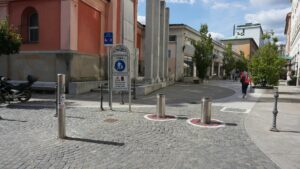Benches in parks, train stations, bus shelters and other public places are meant to offer seating, but only for a limited duration. Many elements of such seats are subtly or overtly restrictive. Arm rests, for instance, indeed provide spaces to rest arms, but they also prevent people from lying down or sitting in anything but a prescribed position. This type of design strategy is sometimes classified as “hostile architecture,” or simply: “unpleasant design.”
Gordan Savičić and Selena Savić, co-editors of the book Unpleasant Design, are quick to point out that unpleasant designs are not failed designs, but rather successful ones in the sense that they deter certain activities by design. A bench which fails to be comfortable and flexible, for example, can still be a successful design … if the designer intends for it to be an uncomfortable place to spend long periods of time.
Unpleasant designs take many shapes, but they share a common goal of exerting some kind of social control in public or in publicly-accessible private spaces. They are intended to target, frustrate and deter people, particularly those who fall within unwanted demographics.
A number of such strategies are aimed loitering teens, and many of these are less physical or obvious than an uncomfortable bench. Some businesses play classical music as a deterrent, on the theory that kids don’t want to hang out or talk over it. Other sound-based strategies include the use of high-frequency sonic buzz generators meant to be audible only to young people. Housing estates in the UK have also put up pink lighting, aimed to highlight teenage blemishes. In many cases, there is little data to show how well these more unconventional strategies actually work.
Read the full article on 99% invisible
Host and producer: Roman Mars
Recommended by Floor van Ditzhuyzen











More Stories
A Space of Our Own
Are superblocks the future of urban living?
Peel Plaza by PolyLester in Amsterdam